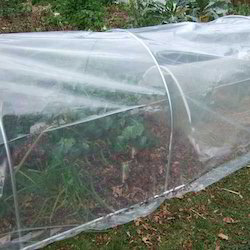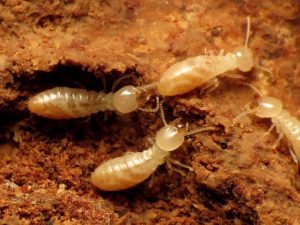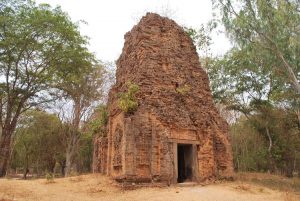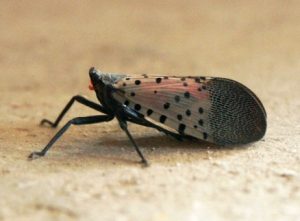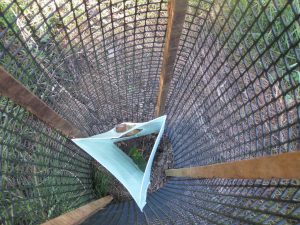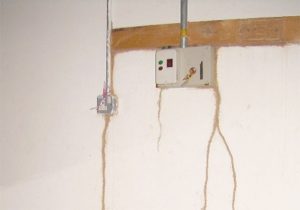 The tiny critters with hairy bodies feast on leaves and wreak havoc on trees.
The tiny critters with hairy bodies feast on leaves and wreak havoc on trees.
Those are the gypsy moths who cause this nuisance.
Gypsy moth caterpillars are easy to identify because they possess characteristics not found on other leaf-feeding caterpillars. They have five pairs of blue dots followed by six pairs of red dots lining the back.
The moth (the adult stage) is usually present in July and August. The male moths are brown and tend to fly in zigzag patterns. The female moths are white or cream colored and do not fly at all. The female lays her eggs in masses, usually on branches and trunks of trees. Egg masses can also be found on patio furniture, recreational vehicles, and other outdoor items. The egg masses are cream or buff in color and about an inch or so in length. The eggs inside is black and palletlike. Each mass may contain 400-600 eggs.
 They are responsible for causing mortality of susceptible host trees. Gypsy moth caterpillars prefer hardwood trees and are known to feed on more than 300 tree species including, but not limited to oak, apple, some poplars, willow, alder, and hawthorn. The caterpillars are defoliators; they eat the leaves of the host trees. Young caterpillars eat small holes in the middle of the leaves, while older caterpillars feed on the outer edge of the leaf inward. Heavy defoliation by the larval stage of this pest causes stress to the infested host plants. Gypsy moths defoliate millions of acres of trees in the United States yearly; repeated infestations weaken and kill the trees.
They are responsible for causing mortality of susceptible host trees. Gypsy moth caterpillars prefer hardwood trees and are known to feed on more than 300 tree species including, but not limited to oak, apple, some poplars, willow, alder, and hawthorn. The caterpillars are defoliators; they eat the leaves of the host trees. Young caterpillars eat small holes in the middle of the leaves, while older caterpillars feed on the outer edge of the leaf inward. Heavy defoliation by the larval stage of this pest causes stress to the infested host plants. Gypsy moths defoliate millions of acres of trees in the United States yearly; repeated infestations weaken and kill the trees.
The nuisance caused by the gypsy moth is spreading vastly and the evidence for it is here!
Gypsy Moths Bring More Bad News to Region
May 03, 2017
By TODD McLeish/ecoRI News contributor
It’s almost gypsy moth caterpillar season again, a time of tree defoliation, a variety of other environmental impacts, and caterpillar droppings raining down upon us. And now comes the news that last year’s infestation may have also affected water quality in the region and will likely do so again.
Gypsy moth caterpillars — along with winter moth caterpillars and forest tent caterpillars, but mostly gypsy moths — defoliated about 230,000 acres in Rhode Island last year, according to the University of Rhode Island entomologist Heather Faubert, making it the worst defoliation since at least the early 1980s. More than half of the state’s 400,000 forested acres were impacted.
Gypsy moth caterpillar droppings, damage to trees ‘a real nuisance’
By Staff Reporter – Posted Jun 27, 2016
BRIDGEWATER – Dave Hanson is not worried about gypsy moths damaging his crops at Hanson Farm. He’s worried about the trees.
“The white oaks, especially, have been devastated by these insects and there is a concern that there’ll be a lot of dead trees around in the next couple of years,” Hanson said at his farm on Pleasant Street in Bridgewater on Sunday.
Gypsy moths “don’t show a preference for any particular tree other than white oaks. But they’ll eat most anything that they can find their way to the leaves including pine,” Hanson said.
Pest control methods have been used to stop the menace the caused by these insects. But those methods did not work to stop the nuisance.
To stop the nuisance caused by these pests there is a need for an effective solution and C Tech Corporation has one!
The unique product Combirepel™ manufactured by C Tech Corporation is an anti-insect aversive which repels insects.
The product available in the form of liquid concentrate can be mixed in paints in a predetermined ratio and lacquer which can be applied topically to the applications.
To keep the insects at the bay Combirepel™ lacquer can be sprayed or coated on the tree trunks. The already installed tree guards can be coated with the lacquer.
 Combirepel™ is available in the form of the masterbatch, which can be incorporated with the polymeric applications like tree guards, irrigation pipes, agricultural films, wires, and cables etc. to keep the gypsy moth away. The polymeric tree guard can be manufactured incorporating our masterbatch into the applications while they are manufactured.
Combirepel™ is available in the form of the masterbatch, which can be incorporated with the polymeric applications like tree guards, irrigation pipes, agricultural films, wires, and cables etc. to keep the gypsy moth away. The polymeric tree guard can be manufactured incorporating our masterbatch into the applications while they are manufactured.
The product is also effective against a multitude of other insects and pests like beetles, mayflies, thrips, aphids, etc. The repelling mechanism of the product would ward off the scale insects and other insects that could damage the trees. Thus, using Combirepel™ would effectively ensure that the area around us remain safe and protected from the pests for a long period of time.
If you are facing problems from the sneaky pests that contact us on technical.marketing@ctechcorporation.com
Also, visit our websites:
http://www.ctechcorporation.com/
http://www.rodrepel.com/
http://www.termirepel.com/
http://www.combirepel.com/
Follow our Facebook pages at:
1] https://www.facebook.com/Combirepel-411710912249274/
2] https://www.facebook.com/Termirepel-104225413091251/
3] https://www.facebook.com/Rodrepel-120734974768048/
Follow us on our Twitter pages at:
1] https://twitter.com/rodrepel
2] https://twitter.com/termirepel
3] https://twitter.com/combirepel
















